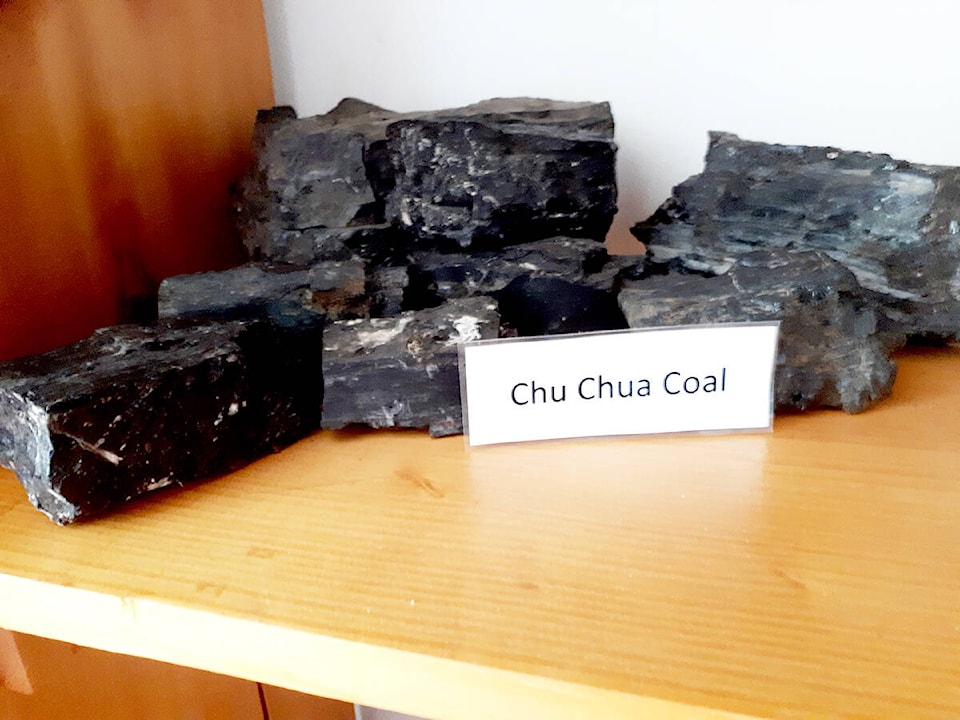By Debbie Hernandez
North Thompson Museum Summer Student
(Information compiled from ‘Exploring Our Roots’ history book)
John Freemont Smith settled in Louis Creek by 1886, and among other activities prospected in the area. J.F. had formed the Kamloops Coal Co. in 1892 to exploit those coal deposits in Chu Chua. His application in 1892 was for a right of way through the reserve and to build an adit to access the coal. The mine was developed east of the present village of Chu Chua by Newhykulston Creek (Coal Creek). There was a road running to the river below the village where the steamboat docked. The company leased 475 acres on the reserve and 1800 acres of crown land. The quality of the coal was good but transport made it uneconomic. The estimated cost per ton at the time were: for hauling was 25 cents, shipping on steamer was $1.75, drayage at Kamloops from streamer 25 cents, loading and unloading 25 cents, loses about 5 % every time transferred because of breakage and pulverizing 25 cents. Value of the coal to the Kamloops Coal Co. in the coal heap at the mine was $1.25 per ton. The property was leased to KCC for $115 per year and a royalty of 10 cents ton. There were no royalties paid and rent was for just one year. The lease was canceled Oct. 14, 1895.
The Chu Chua Coal Mining syndicate was an American based company. They shipped coal to Kamloops soon after the railway was completed. They secured options on about 5000 acres of coal lands. A compressor operated by a 44HP locomotive type of steam boiler was installed and a new road built west to a siding on CN rail about a mile away. The steam plant arrived by train and the dilemma of how to transport it to the mine had to be solved.
Ed Fortier said he could get it up there and the bets were on. He succeeded by using his team and a system of log rollers. As the team pulled the boiler ahead, the rear log was placed at the front with it continuing to move in this manner for a mile until it arrived at the mine.
There were camp buildings at the site to accommodate 20 men. There was a cook house, several small one room cottages, an office, a blacksmith shop and stables. The large managers house was built lower down from the others. Marie Johnson Swallow remembered as a child the small village of well-built homes around the mine site. Mr. Hutchinson may have been the mine manager.
In 1920 there were 16 men employed with 11 underground and five above ground. The cook received $4 a day, labourers $4.50, miner’s helpers $5.50 mechanics $6, miners $7 and supervisors and clerical $9. The output of the colliery for the year was 307 tons. Manuel Eustache worked double shifts in the mine, and a young Frances Casimir delivered goods from the CNR station by horse and buggy to the mine. Dave Casimir worked around doing odd jobs.
When the coal mine shut in the 1920s the men at the Reserve took many of the houses apart, such as the cookhouse that was just above Eddie Celesta’s place. Bill Lampreau’s house by the old church was one of the houses moved from there. The mine managers house was built where Eddie now lives, and burned in the 1960s. Jack Wenlock also moved a small house to Josephine’s property.
To see the coal and learn about the history of the area visit The North Thompson Museum & Archives in Barriere, at 343 Lilley Road. The Museum is open Tuesday to Saturday 10 a.m. to 4 p.m.
_______________
Like us on Facebook
